#Smart Parcel Delivery Locker
Explore tagged Tumblr posts
Text
Global Smart Parcel Delivery Locker Market Size & share Forecast 2022.
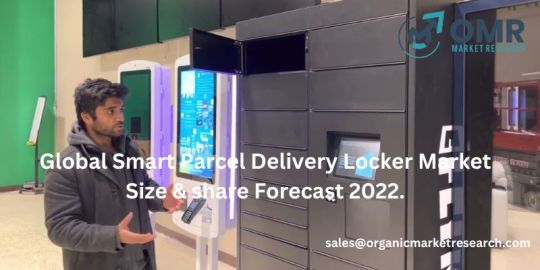
Global Smart parcel lockers are the cutting-edge solution to intelligently manage ever-evolving package and asset delivery demands while providing secure, anytime pick-up options for recipients.
0 notes
Text
https://www.smartboxlockers.com/market/university.php
#smart lockers for libraries#asset management lockers#smart package lockers#apartment delivery lockers#automated parcel lockers
0 notes
Text
Minific: Tiny Purchase
It’s all I’ve been thinking about since I placed my order a couple of days ago. It’s all I’ve been thinking about since this morning too, from the moment I received the delivery notification on my phone. In truth, I haven’t been allowed to forget.
After clicking buy, I’ve been bombarded with relevant content: “How to Enjoy Your Tiny to the Fullest” videos, targeted ads on every site I visit. Cages, kinky dollhouses, tiny tools, and the like. I’m sure I’ll be tempted to purchase a thing or two eventually, but for now, I’ll make do with household items. All I need is a vivid imagination and a bit of resourcefulness.
I step off the bus and into the hub. My parcel is waiting in one of the larger smart lockers. The moment I type in the four-digit code, the door pops open, revealing the carton box inside, plastered with FRAGILE stickers. At least none of them cover the ventilation holes punctured along the sides.
He was thirty percent off, but still top-notch. Two hundred bucks for a six-inch male tiny. Blue eyes, purple hair and my initials tattooed inside his little arm free of charge. The latest genetic modification trend makes for some truly eye-catching combos. I resist the urge to shake the box, to feel the weight shift inside, to listen for the reaction. Instead, I flip the parcel’s handles open. Hey, nice packaging too. As I step away, motion-sensitive ads flash across the hub’s surfaces, adjusting in real-time to what I’m holding and get fresh ads for hot, sexy, vulnerable little things. So, there we have it. I’ve bought into the craze.
And now, straight home with my new property in hand.
I don’t open the package right away. Instead, I heat some noodles, letting the scent curl lazily through the room as I eye my purchase sitting on the desk. The lights outside flicker like a million fireflies, indifferent to me. My window is just one of many in this endless hive of living spaces, but I feel no need to shut the blinds. We’re alone, him and me, in this private little world, even with my window wide open.
I’ve been told I can do whatever I want with him. He’s mine.
Also that he’s a thing. ‘It’.
The thought lingers as I finally reach for the box, pressing my fingers against the cardboard’s edges. A pause. Then, with a deliberate motion, I peel back the seal.
The lid lifts an inch before something inside shifts quickly, nervously. A soft sound, almost imperceptible, like a caught breath. He’s tiny, afraid. Hungry.
I smile.
“Welcome home.”
My Fiction
3 notes
·
View notes
Text
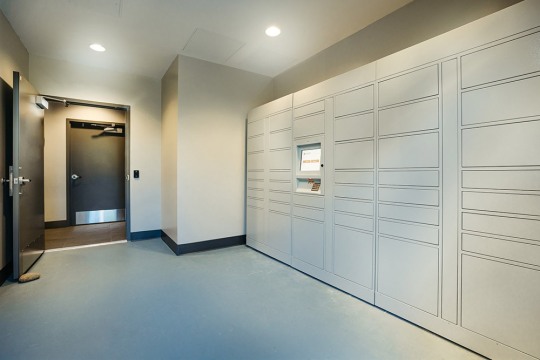
Snaile Lockers Canada offers school lockers for parcel delivery in educational institutions, enabling secure, contactless delivery and pickup of packages on campus. Ideal for staff and student use, these lockers feature durable construction and smart access controls, helping schools manage deliveries efficiently and safely.
0 notes
Text
The Smart Locker Market Size is rapidly expanding, reflecting the growing demand for secure, automated, and efficient parcel delivery solutions. The global Smart Locker Market Size was valued at USD 2.1 billion in 2023 and is estimated to reach USD 3.6 billion by 2028, registering a CAGR of 11.6% during the forecast period.
0 notes
Text
Smart Locker Solution: Parcel Lockers and Smart Storage | VPOD
Smart lockers - Smart locker solution for secure parcel and package delivery. Streamline deliveries and storage with our innovative locker solutions.

Contact Info: Adress:88 Goswell Road, London,EC1V 7DB, United Kingdom Email: [email protected] Phone: +44 (0)20 7621 6300 Website: https://vpod.com/smart-lockers/
1 note
·
View note
Text
Smart Locker Market to Reach $9.3 Billion by 2034: What’s Driving the Growth?
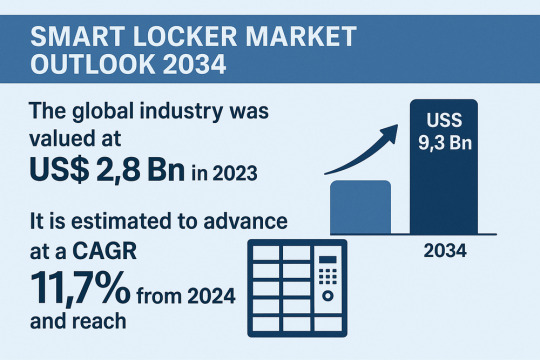
The global smart locker market, valued at USD 2.8 billion in 2023, is poised for robust expansion over the next decade. Driven by surging e-commerce penetration, the need for secure parcel management, and rapid technology adoption across industries, the market is projected to register a compound annual growth rate (CAGR) of 11.7% from 2024 to 2034, reaching USD 9.3 billion by 2034.
Market Overview
Smart lockers secure, automated storage units integrated with sensors, connectivity, and management software are revolutionizing package handling and asset management across residential, commercial, institutional, industrial, and transportation sectors. They offer 24/7 secure access, real-time notifications, and advanced analytics, mitigating risks of theft, loss, and delivery delays. The COVID-19 pandemic underscored the importance of contactless solutions, accelerating deployments in logistics hubs, last-mile delivery networks, corporate campuses, educational institutions, and multi-family dwellings.
Market Drivers & Trends
E-Commerce Boom & Last-Mile Optimization The exponential rise of online shopping has intensified demand for reliable, contactless pickup and drop-off solutions. Retailers and logistics providers deploy smart lockers at convenient locations—supermarkets, transit stations, apartment complexes—to streamline deliveries, reduce failed delivery attempts, and cut operational costs.
Safety & Security Requirements With package theft (“porch piracy”) on the rise, consumers and businesses are adopting smart lockers to secure shipments. Integrated access control (PIN codes, biometrics, smartphone authentication) ensures only authorized users retrieve parcels.
IoT & Cloud-Based Analytics Connectivity via Wi-Fi, Bluetooth, NFC, and cellular networks enables automated monitoring, predictive maintenance, dynamic allocation of locker space, and utilization insights. AI-driven analytics optimize inventory distribution and enhance user experience.
Customized Solutions for Specialized Goods Temperature-controlled lockers support last-mile delivery of perishable groceries, pharmaceuticals, and laboratory specimens. Thermal management and modular compartmentalization ensure product integrity.
Regulatory & Sustainability Pressures Municipalities and corporations seek solutions to reduce carbon footprint of multiple delivery attempts. Consolidated locker deployments lower vehicle miles traveled and greenhouse gas emissions.
Latest Market Trends
Integration with Mobile Wallets & Apps Users increasingly leverage mobile apps and digital wallets to unlock compartments, track package status, and receive push notifications. Mobile-first interfaces are now standard.
Expansion into Multi-Tenant Residential Buildings Property developers embed smart locker ecosystems into new constructions to offer value-added amenities, improve tenant satisfaction, and differentiate offerings.
Plug-and-Play Modular Systems Scalable locker banks enable businesses to expand capacity on-demand. Plug-and-play modules simplify installation and future upgrades.
Partnerships with Last-Mile Tech Providers Collaboration between parcel locker manufacturers and drone, robotics, or autonomous vehicle companies is emerging to create end-to-end automated delivery networks.
Blockchain for Audit Trails Early pilots utilize distributed ledger technology to record chain-of-custody events for high-value shipments, enhancing transparency and reducing disputes.
Access key findings and insights from our Report in this sample - https://www.transparencymarketresearch.com/sample/sample.php?flag=S&rep_id=86223
Key Players and Industry Leaders
Prominent vendors shaping the global smart locker landscape include:
ASSA ABLOY AB – Integrating smart access control across locker portfolios.
Allegion Plc – Broadening product lines with cloud-enabled locker solutions.
Avent Security – Specializing in modular, temperature-controlled lockers.
Dahua Technology – Offering AI-driven surveillance and analytics in locker systems.
dormakaba Group – Combining mechanical expertise with digital management platforms.
Honeywell International Inc. – Delivering enterprise-grade locker management software.
igloocompany Pte Ltd – Pioneering parcel locker networks in Asia.
Master Lock Company LLC. – Known for ruggedized, weatherproof locker designs.
MIWA Lock Co. – Integrating biometric authentication into high-security lockers.
Samsung Electronics Co., Ltd. – Leveraging consumer electronics expertise for locker interface design.
Spectrum Brands, Inc. – Expanding access control offerings into locker portfolios.
Vivint, Inc. – Bundling smart home security with locker access solutions.
These companies focus on R&D, strategic alliances, and targeted acquisitions to enhance technological capabilities and geographic reach.
Recent Developments
November 2023: Blue Dart Express partnered with India Post to install automated digital parcel lockers at select post offices nationwide. Authorized personnel deposit deliveries, and recipients access packages via unique codes—enabling flexible, round-the-clock collection.
March 2022: Quadient and DHL launched an extensive rollout of outdoor smart parcel lockers across Sweden, providing consumers with secure self-service pick-up points and reducing delivery failure rates.
January 2024: igloo expanded its locker network in Singapore’s suburban residential estates, integrating cloud-based analytics to optimize locker utilization and reduce idle capacity.
April 2025: dormakaba introduced biometric-enabled lockers for hospital and laboratory environments, ensuring traceable access to controlled substances and sensitive equipment.
Market New Opportunities and Challenges
Opportunities
Emerging Economies: Rapid urbanization and e-commerce growth in Asia, Latin America, and Africa create fertile ground for locker deployments.
Smart City Initiatives: Municipal plans to deploy shared locker hubs at transit nodes can drive large-scale adoption.
Cross-Industry Convergence: Integration of lockers with coworking spaces, gym facilities, and parcel shops presents new partnership models.
AI-Powered Predictive Maintenance: Leveraging machine learning to foresee component failures enhances uptime and reduces service costs.
Challenges
High Initial Capital Outlay: Infrastructure costs and integration with existing IT systems may deter small and mid-sized enterprises.
Data Security & Privacy: Handling user credentials and tracking data demands robust cybersecurity measures and compliance with evolving regulations (e.g., GDPR).
Interoperability Standards: Absence of universal communication standards across locker ecosystems can hamper large-scale interoperability.
Last-Mile Network Complexity: Integrating lockers into fragmented delivery networks—involving multiple carriers—requires seamless coordination.
Future Outlook
The smart locker market is set to evolve into a critical component of the global logistics and asset-management ecosystem. By 2034, we anticipate:
Hyper-Connected Lockers: Fully integrated into smart city infrastructures, enabling dynamic allocation based on pedestrian and vehicle traffic flows.
Autonomous Replenishment: Drone and robotics fleets replenishing locker stock in real time, responding to demand signals from e-commerce platforms.
Advanced User Experiences: Voice-activated access, augmented reality (AR) wayfinding within locker halls, and AI-driven personalization.
Vertical-Specific Solutions: Tailored offerings for healthcare, cold chain, automotive manufacturing, and other sectors with stringent compliance requirements.
Sustainability Focus: Solar-powered locker banks and carbon-neutral installation programs to align with corporate ESG goals.
Analysts assert that as technology costs decline and value propositions become clearer, adoption will spread beyond major metropolitan areas into suburban and rural markets.
Market Segmentation
Segment
Details
By Type
Deadbolt locks, lever handles, server locks & latches, knob locks, others
By Communication
Bluetooth, Wi-Fi, Z-Wave, NFC, others
By Locking Mechanism
Keypad, card key, touch/biometric, key fob, smartphone
By End-Use
Commercial, residential, institutional & government, industrial, transportation & logistics
Regional Insights
Asia Pacific: Largest market share in 2023, driven by rapid e-commerce expansion, smart city programs, and strong uptake of IoT/cloud computing solutions. Key countries: China, India, Japan, South Korea, ASEAN nations.
North America: High adoption of advanced analytics and strong presence of leading vendors fuel growth. Retail, residential, and institutional segments are particularly active.
Europe: Focus on sustainability and urban logistics optimization. Germany, the U.K., and France lead with smart city pilots and intermodal transport locker installations.
Latin America & MEA: Emerging markets present significant growth potential, though hampered by infrastructural and regulatory challenges.
Why Buy This Report?
This comprehensive report offers:
In-depth market analysis from 2020 to 2023, with detailed forecasts through 2034.
Quantitative units covering market value (US$ billion) and volume (thousand units).
Extensive profiling of leading players, including product portfolios, strategic initiatives, financial overviews, and sales footprints.
Segment-level and regional breakdowns, highlighting growth pockets and investment hotspots.
Detailed qualitative assessments: drivers, restraints, opportunities, Porter’s Five Forces, value chain, and trend analyses.
Ready-to-use Excel datasheets for custom modeling and scenario planning.
Whether you are a technology vendor, investor, logistics provider, or smart city planner, this report equips you with actionable insights to make informed strategic decisions and capitalize on emerging opportunities in the smart locker landscape.
Frequently Asked Questions
1. What is driving the growth of the smart locker market? Surging e-commerce volumes, last-mile delivery challenges, rising concerns over package theft, and the integration of IoT/cloud analytics are key growth drivers.
2. Which regions offer the highest growth potential? Asia Pacific leads today, but Latin America, the Middle East & Africa, and secondary markets in North America and Europe present significant untapped opportunities.
3. What are the main barriers to adoption? High upfront costs, data security/privacy concerns, and the lack of universal interoperability standards across locker ecosystems.
4. How are smart lockers being used beyond parcel delivery? Applications include IT asset management, medical device distribution, temperature-controlled food and pharmaceutical logistics, and secure document storage.
5. Which technologies enhance smart locker capabilities? Bluetooth, NFC, Wi-Fi, biometric authentication, cloud-based management platforms, AI-driven analytics, and emerging blockchain pilots for audit trails.
About Transparency Market Research Transparency Market Research, a global market research company registered at Wilmington, Delaware, United States, provides custom research and consulting services. Our exclusive blend of quantitative forecasting and trends analysis provides forward-looking insights for thousands of decision makers. Our experienced team of Analysts, Researchers, and Consultants use proprietary data sources and various tools & techniques to gather and analyses information. Our data repository is continuously updated and revised by a team of research experts, so that it always reflects the latest trends and information. With a broad research and analysis capability, Transparency Market Research employs rigorous primary and secondary research techniques in developing distinctive data sets and research material for business reports. Contact: Transparency Market Research Inc. CORPORATE HEADQUARTER DOWNTOWN, 1000 N. West Street, Suite 1200, Wilmington, Delaware 19801 USA Tel: +1-518-618-1030 USA - Canada Toll Free: 866-552-3453 Website: https://www.transparencymarketresearch.com Email: [email protected]
0 notes
Text
B2C Shipping Reinvented: What Modern Consumers Really Want
In the fast-paced world of B2C (business-to-consumer) commerce, customer expectations are higher than ever. Shoppers are no longer satisfied with simply receiving their orders—they want speed, flexibility, transparency, and a seamless post-purchase experience. At LogyXpress, we’re helping businesses stay ahead by completely reinventing B2C shipping to align with what modern consumers truly want.
Speed That Matches Today’s Lifestyle
Let’s face it: modern shoppers live in an on-demand world. Whether it’s groceries, gadgets, or gifts, they want their items delivered yesterday. Next-day and same-day delivery are no longer a luxury—they’re becoming the new normal.
At LogyXpress, we use smart logistics technology, including AI-driven route planning and decentralized fulfillment, to drastically reduce delivery times. Our distributed network of fulfillment hubs enables local shipping for faster, more reliable last-mile delivery—giving consumers what they want, exactly when they want it.
Free (or Affordable) Shipping Options
Shipping cost is one of the top reasons for cart abandonment. Customers expect either free shipping or low-cost alternatives—especially on B2C platforms where convenience is king.
LogyXpress helps businesses offer cost-effective shipping solutions by optimizing packaging, reducing dimensional weight, and providing access to negotiated carrier rates. With customizable delivery thresholds like “Free shipping over £40,” businesses can drive conversions while maintaining profitability.
Flexibility & Control
Today’s consumers want control over their delivery experience. That means choosing delivery windows, updating shipping addresses, and tracking their parcels in real time.
Our LogyXpress dashboard gives customers a personalized shipping journey—complete with live tracking, SMS/email updates, and the ability to reschedule or reroute deliveries on the fly. This transparency reduces missed deliveries and enhances overall satisfaction.
We also support alternative delivery methods, including pick-up lockers, click-and-collect options, and green delivery for eco-conscious shoppers.
Seamless Returns = Happy Customers
A frictionless return process is a major trust builder in B2C eCommerce. According to industry reports, over 60% of online shoppers check return policies before making a purchase.
LogyXpress simplifies returns with automated return portals, pre-paid labels, and reverse logistics solutions that make it easy for customers to send items back. This helps brands reduce return friction, boost loyalty, and even encourage repeat purchases.
Tech-Powered Shipping, Human-Centric Service
While automation is at the heart of our logistics system, we never forget the human side. LogyXpress combines cutting-edge technology with responsive customer service, ensuring both merchants and shoppers have a smooth experience every step of the way.
Our integrations with major eCommerce platforms like Shopify, WooCommerce, and Magento allow B2C brands to streamline operations and focus on growth while we handle the heavy lifting.
Conclusion
Modern consumers want more than just products—they want experiences. By offering fast, flexible, and customer-focused shipping, LogyXpress is helping B2C brands build stronger relationships, reduce churn, and stay competitive in a dynamic market.
Whether you’re a growing D2C brand or an established retailer looking to scale, LogyXpress is your partner in delivering the future of B2C shipping—smart, seamless, and made for the modern shopper.
0 notes
Text
Parcel Delivery Logistics Market Outlook, Analysis, Report 2024-2031
BlueWeave Consulting, a leading strategic consulting and market research firm, in its recent study, estimated Global Parcel Delivery Logistics Market size at USD 496.28 billion. During the forecast period between 2025 and 2031, BlueWeave expects Global Parcel Delivery Logistics Market size to expand at a CAGR of 5.1% reaching a value of USD 702.98 billion by 2031. The Parcel Delivery Logistics Market across the regions is propelled by the rapid expansion of e-commerce and increasing consumer demand for faster, more convenient deliveries. This surge has driven advancements in logistics infrastructure and technology, enhancing distribution speed and operational efficiency. Globalization is further amplifying demand for small-package services capable of handling international shipments, while innovations in last-mile delivery—such as drones, electric vehicles (EVs), and smart locker systems—are improving accessibility in both urban and rural areas. Companies are leveraging tracking systems and data analytics to optimize supply chain management, enhance customer experience, and integrate real-time tracking with sustainable delivery options. In line with this growth, Deutsche Post AG expanded its European e-commerce parcel network by acquiring Turkey’s MNG Kargo in October 2023. With 27 sorting centers and 800 branches, MNG Kargo strengthens DHL eCommerce’s cross-border logistics capabilities, capitalizing on Turkey’s booming e-commerce sector. This strategic move reflects the evolving landscape of global parcel delivery, where technology, efficiency, and shifting consumer expectations continue to reshape the industry.
Sample Request: https://www.blueweaveconsulting.com/report/parcel-delivery-logistics-market/report-sample
Impact of Escalating Geopolitical Tensions on Global Parcel Delivery Logistics Market
Intensifying geopolitical tensions could disrupt the growth of Global Parcel Delivery Logistics Market. Supply chain resilience, once a strategic advantage, is now a fundamental imperative. Escalating tensions precipitate a cascade of disruptions: trade barriers proliferate, fuel costs fluctuate wildly, and security protocols tighten, collectively eroding cross-border efficiency. Forward-thinking logistics providers are responding with agile strategies, diversifying networks, pioneering alternative transit corridors, and deploying advanced technologies to navigate this era of persistent uncertainty.
Asia Pacific Leads Global Parcel Delivery Logistics Market
The Asia Pacific (APAC) region continues to dominate Global Parcel Delivery Logistics Market. It is driven by the rapid expansion of the APAC region's e-commerce sector and its extensive consumer base. Significant growth in online retail is observed in key markets, such as China, Japan, and India, fueled by deepening internet penetration, rising disposable incomes, and accelerated urbanization. In particular, China, with its established e-commerce platforms, like Alibaba and JD.com, relies on sophisticated logistics networks to ensure efficient and timely deliveries. Furthermore, strategic investments in logistics infrastructure have enhanced operational efficiency and expanded supply chain reach across both domestic and international markets. The surge in cross-border e-commerce activity further stimulates demand for comprehensive parcel delivery services. Recent strategic developments, such as CMA CGM Group's acquisition of Bolloré Logistics for approximately USD 5.6 billion in February 2024, indicate ongoing consolidation and expansion within the sector. This acquisition, which strengthens CMA CGM's ocean and air freight capabilities, is expected to contribute to the continued growth and evolution of the Asia-Pacific parcel delivery logistics market.
Competitive Landscape
Major companies in Global Parcel Delivery Logistics Market include FedEx Corporation, DHL, United Parcel Service, Inc., Allcargo Gati, Deutsche Post AG, Ekart Logistics, Yamato Holdings Co., Ltd, China Post Group Corporation, Japan Post Holdings Co., Ltd, SF Holding Co., Ltd, Canada Post Corporation, Royal Mail Group Ltd, and Aramex International LLC. The presence of high number of companies intensify the market competition as they compete to gain a significant market share. These companies employ various strategies, including mergers and acquisitions, partnerships, joint ventures, license agreements, and new product launches to further enhance their market share.
Contact Us:
BlueWeave Consulting & Research Pvt Ltd
+1 866 658 6826 | +1 425 320 4776 | +44 1865 60 0662
0 notes
Text
How Courier Companies Are Adapting to the Rise of Online Shopping

Online shopping has revolutionised the logistics industry and forced courier companies in Australia and worldwide to modernise and adapt. With the growing development of e-commerce, customers expect faster, more dependable, and more affordable deliveries than ever. The shift from traditional retail to online buying has compelled courier companies to enhance performance and monitoring skills and optimise last-mile transport services.
Freight Save understands how necessary it is for businesses to cope with the evolving logistics scenario. In this weblog, we explore how Courier companies in Australia are adapting to the surge in online purchasing and ensuring seamless delivery experiences for clients.
1. Investing in Faster and More Efficient Delivery Services
Online customers prefer quick delivery options, like next-day delivery in Australia, same-day shipping, and even instant deliveries. To meet these demands, courier agencies are:
Expanding Delivery Networks – Shipping aggregator like Freight Save collaborates with many trusted logistics companions and warehouses to lessen transit times.
Optimising Routes with AI and GPS Tracking – Using advanced route optimisation to stop delays and minimise fuel prices.
Offering Flexible Delivery Windows – Allowing customers to schedule flexible deliveries.
2. Enhancing Last-Mile Delivery Solutions
Last-mile shipping is the last step of the transport system and is the most difficult and costly part of shipping. To enhance this part, Courier companies in Australia are:
Utilising Local Delivery Hubs – Setting up local delivery hubs closer to major towns to make shipments fast.
Providing Real-Time Tracking and Notifications – Freight Save keeps you informed every step of the way, from pickup to delivery, providing timely updates on delivery times and any potential delays.
3. Expanding Next-Day and Same-Day Delivery Options
With e-commerce industries setting standards for next-day delivery in Australia, courier partners are improvising their shipping standards by:
Introducing Express Delivery Services – Providing high-speed delivery for urgent orders.
Partnering with Retailers for Store-to-Door Deliveries – Reducing reliance on traditional warehouses.
Offering Subscription-Based Shipping Plans – Courier companies in Australia provide unlimited express delivery for customers.
With Freight Save, you have access to a wide range of transport services, from standard parcel delivery to express shipping for large gadgets.
4. Strengthening Contactless and Secure Delivery Methods
The shift to online shipping accelerated during the pandemic; however, it has now become a permanent function in logistics. Courier companies in Australia have adopted the following:
Smart Lockers and Pickup Points – Allowing clients to acquire parcels from their choice-able spots.
6. Sustainability Initiatives in E-Commerce Logistics
With accelerated online purchasing comes a rise in carbon emissions and packaging waste. To counteract this, shipping companies are:
Investing in Electric and Hybrid Delivery Vehicles – Reducing fuel consumption.
Implementing Eco-Friendly Packaging – Encouraging reusable and biodegradable substances.
Final Thoughts
The acceleration of e-commerce has driven courier companies to innovate, imparting faster, smarter, and more sustainable delivery solutions. Whether enhancing last-mile delivery, automating logistics, or expanding next-day delivery in Australia, the industry continues to fulfill customer satisfaction.
At Freight Save, we make it smooth for businesses to navigate these changes with professional freight help, an advanced platform, and an extensive range of courier services. Whether you need less expensive standard parcel delivery or express shipping for bulk orders, we have the proper solutions for your business.
0 notes
Text
We make all kinds of smart cabinets, like parcel delivery locker, smart storage locker, key management cabinet, etc. Custom any size any color.
0 notes
Text
https://www.smartboxlockers.com/market/university.php
#smart lockers for libraries#asset management lockers#smart package lockers#apartment delivery lockers#automated parcel lockers
0 notes
Text
Smart Parcel Locker Market 2025 Size, Share, Growth Trends Forecast to 2032
The global Smart Parcel Locker Market size is expected to grow from USD 902.6 million in 2023 to USD 2,552.4 million by 2032, at a Compound Annual Growth Rate (CAGR) of 12.3% during the forecast period.
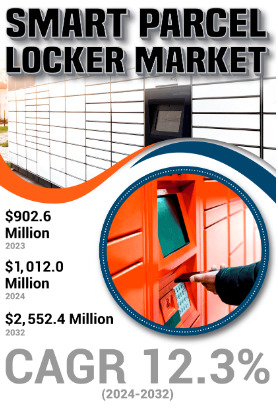
The recently released Fortune Business Insights research on the Global Smart Parcel Locker Market survey report provides facts and statistics regarding market structure and size. Global Smart Parcel Locker Market Size 2025 Research report presents an in-depth analysis of the Global Market size, growth, share, segments, manufacturers, and forecast, competition landscape and growth opportunity. The research’s goal is to provide market data and strategic insights to help decision-makers make educated investment decisions while also identifying potential gaps and development possibilities.
Companies Profiled in the Global Smart Parcel Locker Market:
Ricoh Group (Japan)
Quadient SA (France)
TZ Limited (Australia)
Pitney Bowes Inc. (U.S.)
KEBA Group AG (Austria)
Cleveron (Estonia)
LUXER Corporation (U.S.)
ParcelPort Solutions, Inc. (Canada)
Hollman, Inc. (U.S.)
Shenzhen Zhilai Sci and Tech Co. (China)
Upsurge in E-Commerce Deliveries to Fuel the Smart Parcel Locker Market Growth
The drastically developing online retailing trend is rising e-commerce demand. Over a few years, numerous corporations observed growth in delivery volumes. Various industry segments, such as food and beverages, apparels and accessories, personal care, and consumer electronics goods, perceived sharp growth in their parcel delivery volume. Brick and mortar retail stores are now moving toward e-commerce and digital platforms to distribute products to consumers.
What exactly is included in the Report?
– Industry Trends and Developments: In this section, the authors of the research discuss the significant trends and developments that are occurring in the Smart Parcel Locker Market place, as well as their expected impact on the overall growth.
– Analysis of the industry’s size and forecast: The industry analysts have provided information on the size of the industry from both a value and volume standpoint, including historical, present and projected figures.
– Future Prospects: In this portion of the study market participants are presented with information about the prospects that the Smart Parcel Locker Market is likely to supply them with.
– The Competitive Landscape: This section of the study sheds light on the competitive landscape of the Smart Parcel Locker Market by examining the important strategies implemented by vendors to strengthen their position in the global market.
– Study on Industry Segmentation: This section of the study contains a detailed overview of the important Smart Parcel Locker Market segments, which include product type, application, and vertical, among others.
– In-Depth Regional Analysis: Vendors are provided with in-depth information about high-growth regions and their particular countries, allowing them to place their money in more profitable areas.
This Report Answers the Following Questions:
What are the Smart Parcel Locker Market growth drivers, hindrances, and dynamics?
Which companies would lead the market by generating the largest revenue?
How will the companies surge the processes adoption amid the COVID-19 pandemic?
Which region and segment would dominate the Smart Parcel Locker Market in the coming years?
Smart Parcel Locker Market Segments:
By Component
Hardware
Software
By Deployment
Indoor
Outdoor
By Type
Modular Parcel Lockers
Cooling Lockers for Fresh Food
Postal Lockers
Laundry Lockers
By Application
Commercial Buildings
Condos and Apartments
Retail BOPIS
Universities and Colleges
Others (Post Offices, Parking Areas)
Table Of Content:
1. Introduction 1.1. Research Scope 1.2. Market Segmentation 1.3. Research Methodology 1.4. Definitions and Assumptions
2. Executive Summary
3. Market Dynamics 3.1. Market Drivers 3.2. Market Restraints 3.3. Market Opportunities
4. Key Insights 4.1 Global Statistics — Key Countries 4.2 New Product Launches 4.3 Pipeline Analysis 4.4 Regulatory Scenario — Key Countries 4.5 Recent Industry Developments — Partnerships, Mergers & Acquisitions
5. Global Smart Parcel Locker Market Analysis, Insights and Forecast 5.1. Key Findings/ Summary 5.2. Market Analysis — By Product Type 5.3. Market Analysis — By Distribution Channel 5.4. Market Analysis — By Countries/Sub-regions
……………
11. Competitive Analysis 11.1. Key Industry Developments 11.2. Global Market Share Analysis 11.3. Competition Dashboard 11.4. Comparative Analysis — Major Players
12. Company Profiles
12.1 Overview 12.2 Products & Services 12.3 SWOT Analysis 12.4 Recent developments 12.5 Major Investments 12.6 Regional Market Size and Demand
13. Strategic Recommendations
TOC Continued……………….
0 notes
Text
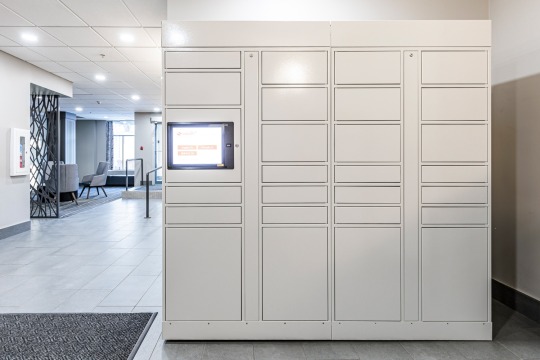
Manage deliveries effortlessly with apartment package lockers from Snaile Lockers Canada. These smart, secure lockers provide residents with a reliable solution for safe and convenient parcel storage. Explore the benefits for your building today!
0 notes
Text
Analyzing the Impact of AI on the Smart Locker Market: Trends and Future Outlook
The integration of Artificial Intelligence (AI) into the smart locker market is reshaping the way businesses and consumers interact with secure storage and parcel delivery systems. AI-powered smart lockers are no longer just passive storage units; they are becoming intelligent systems that can make real-time decisions, improve operational efficiency, enhance user experience, and drive sustainability across industries. As the demand for contactless, secure, and efficient parcel handling solutions rises, AI is at the forefront of innovation in this evolving market.
Download PDF Brochure @ https://www.marketsandmarkets.com/pdfdownloadNew.asp?id=209948292
AI-Driven Transformation in Smart Lockers
AI brings advanced capabilities such as predictive analytics, facial recognition, smart routing, dynamic access control, and remote monitoring to the smart locker ecosystem. These capabilities are enabling service providers to deliver more reliable, personalized, and secure experiences to users across sectors like logistics, e-commerce, residential housing, education, and corporate environments.
Key AI Applications in Smart Lockers:
Predictive Maintenance: AI algorithms can analyze locker usage data to predict potential failures or maintenance needs, minimizing downtime.
Facial Recognition and Biometric Access: Enhances security and provides touchless access, aligning with post-pandemic hygiene preferences.
Optimized Routing and Delivery: AI can streamline last-mile delivery by predicting optimal drop-off points and usage patterns, reducing delivery time and costs.
User Behavior Analytics: Helps businesses understand user preferences and tailor locker services accordingly.
Inventory Management and Automation: Especially useful in B2B applications, AI can automate storage and retrieval operations, improving supply chain visibility.
Market Trends Accelerating AI Integration
1. E-commerce Expansion and Contactless Deliveries
The surge in online shopping has led to a parallel increase in demand for secure, self-service delivery options. Smart lockers powered by AI can manage high delivery volumes efficiently while ensuring timely pickups and returns.
2. Smart Cities and Urbanization
Smart lockers are being deployed in public spaces like malls, metro stations, and residential complexes as part of broader smart city initiatives. AI enhances their utility by enabling data-driven decisions about locker placement and usage.
3. Omnichannel Retail Strategies
Retailers are using AI-enhanced smart lockers to offer click-and-collect and return services, bridging the gap between digital and physical retail channels while reducing staffing requirements and operational bottlenecks.
4. Rise of PropTech and Smart Buildings
In multi-unit residential and office buildings, AI-driven lockers support secure, unattended deliveries and simplify package management, especially in high-density urban areas.
Challenges and Considerations
Despite its benefits, integrating AI into smart locker systems comes with challenges:
Data Privacy and Security: As biometric and user behavior data is collected, regulatory compliance and cybersecurity become crucial.
Initial Investment Costs: AI-enabled lockers are more expensive to install and maintain, which may deter small-scale providers.
Integration Complexity: Seamless integration with logistics, property management, or ERP systems can be technically challenging.
Future Outlook
The global smart locker market is projected to grow significantly over the next decade, driven by urban logistics, AI innovation, and the increasing emphasis on automation and user convenience. According to industry analysts, the adoption of AI will be a major differentiator in locker systems, enabling:
Real-time locker utilization insights for fleet optimization.
Fully autonomous delivery hubs integrated with drones or autonomous vehicles.
AI-powered customer support and chatbots integrated with locker kiosks.
Energy-efficient locker operations guided by machine learning algorithms.
0 notes